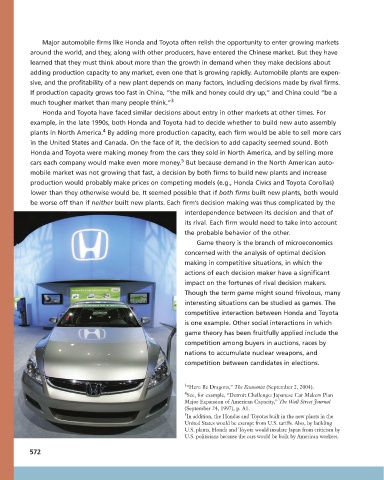Page 598 - Microeconomics, Fourth Edition
P. 598
c14gametheoryandstrategicbehavior.qxd 8/6/10 8:22 AM Page 572
Major automobile firms like Honda and Toyota often relish the opportunity to enter growing markets
around the world, and they, along with other producers, have entered the Chinese market. But they have
learned that they must think about more than the growth in demand when they make decisions about
adding production capacity to any market, even one that is growing rapidly. Automobile plants are expen-
sive, and the profitability of a new plant depends on many factors, including decisions made by rival firms.
If production capacity grows too fast in China, “the milk and honey could dry up,” and China could “be a
much tougher market than many people think.” 3
Honda and Toyota have faced similar decisions about entry in other markets at other times. For
example, in the late 1990s, both Honda and Toyota had to decide whether to build new auto assembly
4
plants in North America. By adding more production capacity, each firm would be able to sell more cars
in the United States and Canada. On the face of it, the decision to add capacity seemed sound. Both
Honda and Toyota were making money from the cars they sold in North America, and by selling more
5
cars each company would make even more money. But because demand in the North American auto-
mobile market was not growing that fast, a decision by both firms to build new plants and increase
production would probably make prices on competing models (e.g., Honda Civics and Toyota Corollas)
lower than they otherwise would be. It seemed possible that if both firms built new plants, both would
be worse off than if neither built new plants. Each firm’s decision making was thus complicated by the
interdependence between its decision and that of
its rival. Each firm would need to take into account
the probable behavior of the other.
Game theory is the branch of microeconomics
concerned with the analysis of optimal decision
making in competitive situations, in which the
actions of each decision maker have a significant
impact on the fortunes of rival decision makers.
Though the term game might sound frivolous, many
interesting situations can be studied as games. The
competitive interaction between Honda and Toyota
is one example. Other social interactions in which
game theory has been fruitfully applied include the
competition among buyers in auctions, races by
nations to accumulate nuclear weapons, and
competition between candidates in elections.
3 “Here Be Dragons,” The Economist (September 2, 2004).
4 See, for example, “Detroit Challenge: Japanese Car Makers Plan
Major Expansion of American Capacity,” The Wall Street Journal
(September 24, 1997), p. A1.
5 In addition, the Hondas and Toyotas built in the new plants in the
United States would be exempt from U.S. tariffs. Also, by building
U.S. plants, Honda and Toyota would insulate Japan from criticism by
U.S. politicians because the cars would be built by American workers.
572

